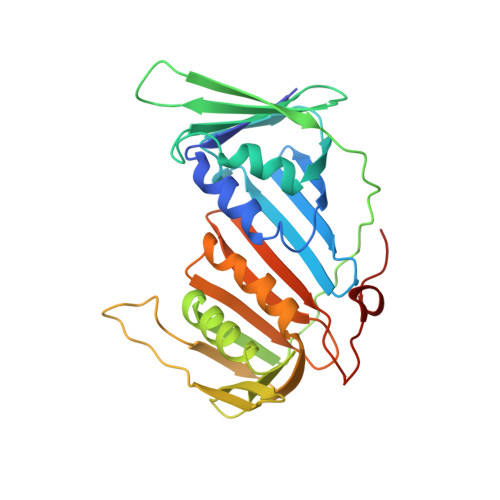Structural Basis for the Interaction Between Yeast Chromatin Assembly Factor 1 and Proliferating Cell Nuclear Antigen.
Orndorff, K.S., Veltri, E.J., Hoitsma, N.M., Williams, I.L., Hall, I., Jaworski, G.E., Majeres, G.E., Kallepalli, S., Vito, A.F., Struble, L.R., Borgstahl, G.E.O., Dieckman, L.M.(2024) J Mol Biol 436: 168695-168695
- PubMed: 38969056
- DOI: https://doi.org/10.1016/j.jmb.2024.168695
- Primary Citation of Related Structures:
8THW - PubMed Abstract:
Proliferating cell nuclear antigen (PCNA), the homotrimeric eukaryotic sliding clamp protein, recruits and coordinates the activities of a multitude of proteins that function on DNA at the replication fork. Chromatin assembly factor 1 (CAF-1), one such protein, is a histone chaperone that deposits histone proteins onto DNA immediately following replication. The interaction between CAF-1 and PCNA is essential for proper nucleosome assembly at silenced genomic regions. Most proteins that bind PCNA contain a PCNA-interacting peptide (PIP) motif, a conserved motif containing only eight amino acids. Precisely how PCNA is able to discriminate between binding partners at the replication fork using only these small motifs remains unclear. Yeast CAF-1 contains a PIP motif on its largest subunit, Cac1. We solved the crystal structure of the PIP motif of CAF-1 bound to PCNA using a new strategy to produce stoichiometric quantities of one PIP motif bound to each monomer of PCNA. The PIP motif of CAF-1 binds to the hydrophobic pocket on the front face of PCNA in a similar manner to most known PIP-PCNA interactions. However, several amino acids immediately flanking either side of the PIP motif bind the IDCL or C-terminus of PCNA, as observed for only a couple other known PIP-PCNA interactions. Furthermore, mutational analysis suggests positively charged amino acids in these flanking regions are responsible for the low micromolar affinity of CAF-1 for PCNA, whereas the presence of a negative charge upstream of the PIP prevents a more robust interaction with PCNA. These results provide additional evidence that positive charges within PIP-flanking regions of PCNA-interacting proteins are crucial for specificity and affinity of their recruitment to PCNA at the replication fork.
Organizational Affiliation:
Department of Chemistry and Biochemistry, Creighton University, Omaha, NE, USA.














